ER confers awards for performance
Milind Deouskar, general manager of Eastern Railway, handed over the GM’s Overall Efficiency Shield to Asansol Division.
Within a fortnight, the degree of air pollution in the industrial cities of Durgapur and Asansol have further crossed the pollution levels of the country’s highest polluted cities in recent times.

Representation image
Within a fortnight, the degree of air pollution in the industrial cities of Durgapur and Asansol have further crossed the pollution levels of the country’s highest polluted cities in recent times.
The censors at Bidhannagar, one of the three measuring locations in Durgapur, recorded highly hazardous AQI (air quality index) level at 420 at 12.28 pm on Wednesday, followed by 361 at B-Zone and 302 at City Centre in the heart of Durgapur city. On 27 November, the AQI in Durgapur was 423 with PM10 particulate level at 256 micrograms per metre-cube.
Advertisement
Today, the soaring heavier PM10 pollutant recorded at 174 micrograms per metre-cube of ambient air in Durgapur and PM2.5 scaled up to 91 micrograms per metre-cube. The permeable level of these two pollutants in 24 hours is – 45 micrograms and 5 micrograms per metre-cube of ambient air. Such pollutants are generated from the steel units and thermal power units, besides vehicular pollution. Gaurav Jajodia, director, steel maker Jai Balaji group, while declaring a marathon here, said today, “We’ve stressed for green steel and green energy production deploying adequate pollution control devices.”
Advertisement
At Ajit Singh Nagar in Chandigarh and at Pusa in Delhi, the two major polluted locations, recorded AQI today at 147 and 228, respectively.
Bengal’s coal town Raniganj, the neighbouring city of Durgapur recorded AQI at 366, which too was much lower than Durgapur today. “Considering the situation, as was prescribed by the authorities, we’ve already started planting three-tier bio-seal composed of Deodar cedar highrise trees along the Jharkhand border, besides water sprinkling,” said Sudip Bhattacharya, environmental engineer, Asansol. IIT Kanpur assigned to facilitate technical measures to check pollution of Asansol Durgapur recently suggested bio-seal for the purpose.
The Durgapur administration meanwhile has assigned a private engineering college to provide technical measures to check air pollution. Sourabh Chatterjee, SDM, Durgapur said: “They will assist us for this.”
Advertisement